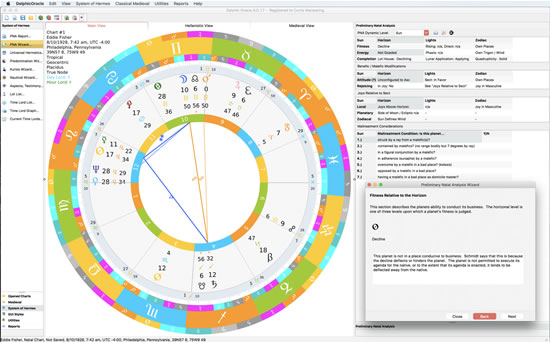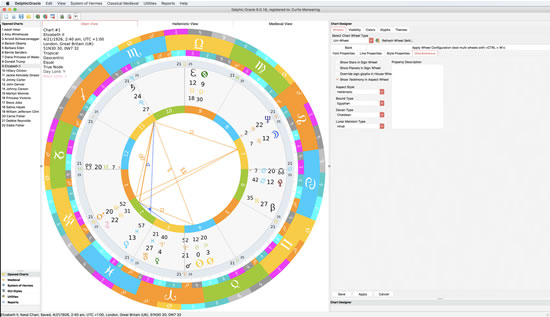About the System of Hermes
We come to what makes Delphic Oracle completely unique with this section. The System of Hermes is Robert Schmidt's name for the theoretical construction by the putative founder of Greek / Hellenistic astrology (which he believes is Eudoxus of Knidos) and is based upon his understanding translating ancient astrological Greek and Latin texts since the early 90's. He has given me permission to include some of his interpretive material in Delphic Oracle which is why it doesn't exist in any other program. I've been closely involved with Project Hindsight since 1994 and witnessed changes in the astrological community as this material gained in popularity during the 90's and 00's because of Schmidt's lectures on the subject which is why the term "Hellenistic" astrology is on the map.
This system is categorized into 4 parts (PNA - Preliminary Natal Analysis), Universal Hermetics, Topics and Time Lords. Since the Time Lord procedures have already been discussed, in this section I will explain the rest here. The system is laid out in the natural order of investigation during study of a nativity (from top to bottom in the System of Hermes menu and Group bar). The Preliminary Natal Analysis window is shown below to the right side of the chart.
The Preliminary Natal Analysis (PNA for short), has both a main window and wizard to explain each of the "cells" in the main window. The Wizard is showing below and as is the case with the main window, there's 7 possible selections (the 7 visible planets) to analyze. This wizard has 19 sections and each section has a separate conclusion.
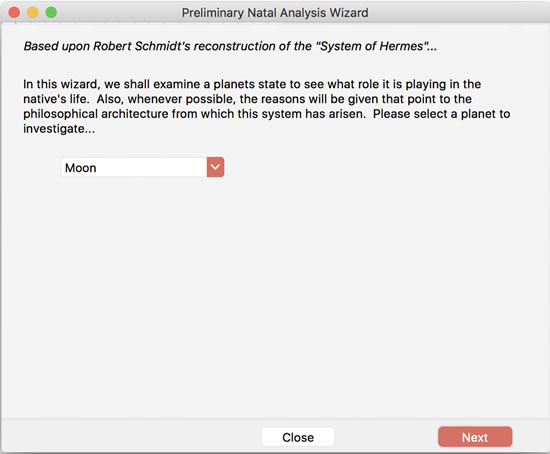
You will notice a 3 fold repetition in the layout which is one of the reasons why Schmidt came to the conclusion that Hellenistic astrology was primarily a theoretical construct. In contrast to modern psychological astrology which equates chart positions with internal workings of the psyche, Hellenistic astrology tends to look at the life from an external objective position where the planets provide testimony and witness certain events happen. As they become time lords, they begin to speak and cause manifestation. Knowing on which level a planet is working on has to do with understanding whether it's effects belong to the level of heimarmene (the zodiacal/planetary level as seed potential), what is promised, vs (and sometimes in contradiction) what is more likely to be made manifest (at the horizon, the level of tuche (aka fortune)). This has philosophical implications as to whether as Schmidt says "one gets ones due".
Fitness relative to the horizon
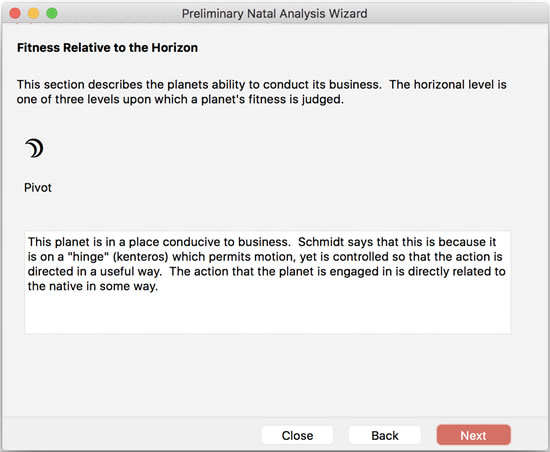
Here we see whether a planet is able to bring it's effects to bear on the natives life effectively (angular) or whether it's effects are deflected away (cadent) or whether it's effects are eventually brought to bear (succeedent). These three categories have different Greek names (kentron, apoklima or proanophora, epanophora). If a planet is conducive to business, it's effects will be more readily noticible, whereas cadent planets will generally be less effective or manifest peripherally to the native. Schmidt said that this is one of the reasons why malefics joy in the 6th or 12th (Mars and Saturn), is because they direct their maleficence away from the native while being connected to the native. This is not always the case however for reasons we'll explore later (based on eminence). Metaphysically if the planets are cadent, then one is not "centered on the world" because such places are considered "metacosmious" (literally meaning "between worlds").
Fitness relative to the lights
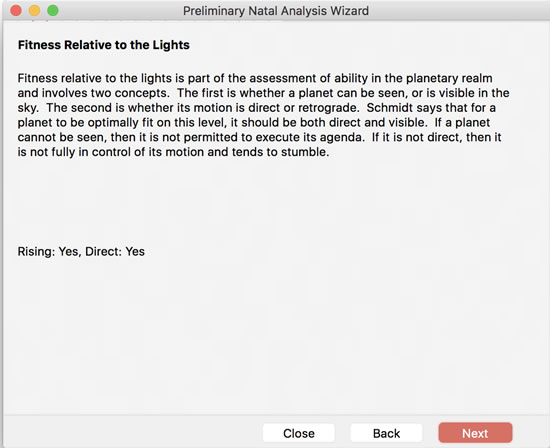
Here we see one of the composite concepts so common in Hellenistic astrology. Ideally a planet should be able to "rise up" and not be in a stumbling state (either moving backwards or hiding in some way as to go unnoticed). Direct and visible is the ideal here which indicates that the planets manifestation is less encumbered. This plays heavily into fitness later on when a planet is judged capable of being the captain of one's ship (aka chart ruler) in what is known as the "nautical metaphor". If a planet is direct and visible, it has maximized it's potential on the planetary level.
Fitness relative to the zodiac
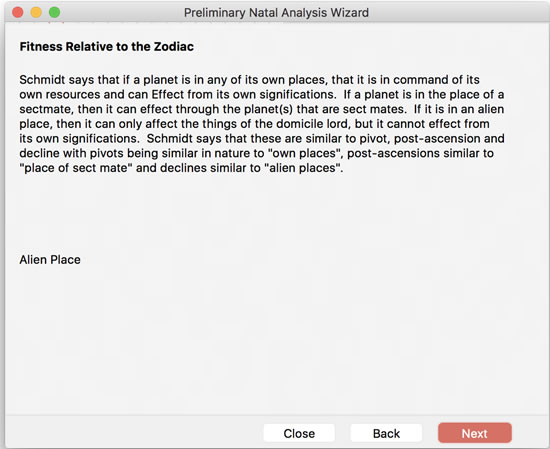
Here we see on what potential significations a planet is most likely to manifest. If this is one of the malefics and it's an alien place as shown above, it can't bring about any of it's own significations in favor of the native, but instead trashes the significations of that place. So for instance if Saturn by night happens to be in the 2nd house in an alien place, then it trashes the significations such as finances, making defective ones possessions or loss, and theft, diminishing what supports the native. But if in their own places, it will bring out more positive potentials effecting from its own significations (in this case, one who is miserly and conservative financially, one fortunate in antiques, etc).
Energy relative to the horizon
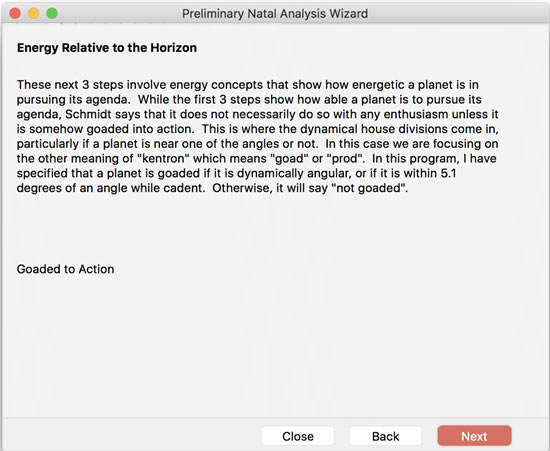
In this case we find how motivated a planet is to produce its effects whatever they may be. Sometimes planets are very capable but not motivated, other times they can be very motivated, but lack ability. If we imagine someone who is a musician, the first case where planets are in their own places might indicate a highly gifted musician, but if that position is cadent, they're playing in a local bar. If the reverse, then we have someone prone to get an engagement above their ability who gets to mess up their performance at Carnegie Hall, or of course somewhere in between.
Energy relative to the lights
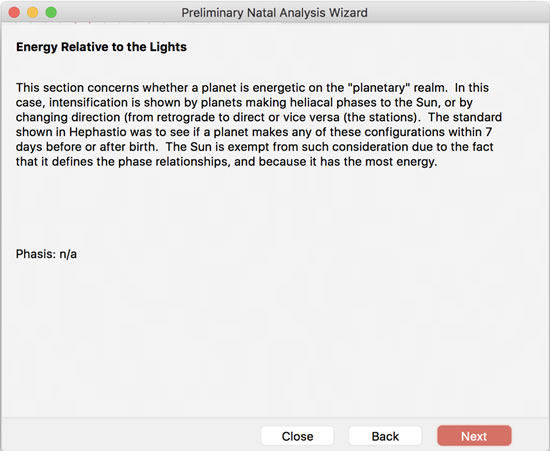
While the last consideration closely relates to venue due to its terrestrial connection, this again has more to do with the strength of the testimonial accounts between the planets, whether they are shouting in their aspect relations or whether they are speaking softly. The planets that speak the loudest are more likely to make a noticeable impact.
Energy relative to the zodiac
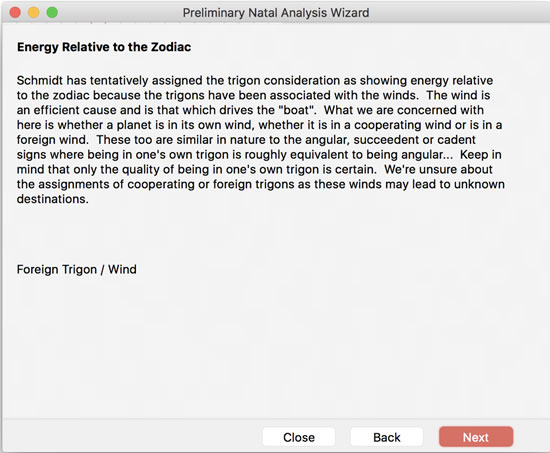
This consideration was largely speculative by Schmidt, but I think that when planets are in their own "winds" the promise at the level of heimarmene is one of greater eminence and far reaching impact. This is a higher realm and just as is the case in the sky, winds close to the ground tend to be slower and don't move as far, whereas those higher up eventually reach the jet stream going very fast. Within the context of the nautical metaphor (explained below) we'll see that such planets make the native go far in life when they're in their own winds, but a planet in a contrary wind has to struggle upstream.
Completion relative to the horizon
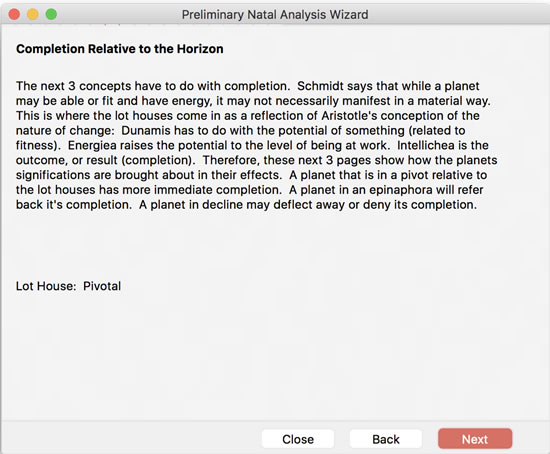
We can think of this level as the last stop in the long chain of events as to what happens when it becomes active as a time lord. Some promises can't be kept, while others are delivered at the appropriate time. In the technique known as zodiacal releasing, it is the angular fortune houses that deliver it's effects most strongly.
Completion relative to the lights
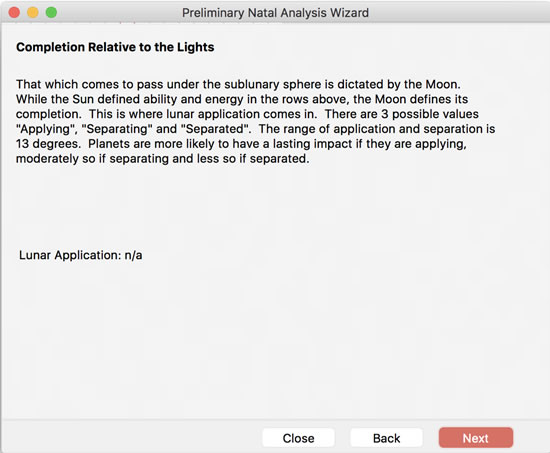
This completion level determines whether there is something in the promise that is held back in some way before it even reaches completion (manifestation). Because the Moon is closely related to the terrestrial sphere it is just above considerations that have to do with the houses. It is said that the Moon is responsible for moderating the other planets and sending its "effluvia" to the terrestrial level. This is where the messages regarding testimony and witnessing at the planetary level get sent. It represents the final verdict at the level of the cosmic courtroom (Schmidt's legal paradigm). In this case the Moon isn't considered which will show n/a (not applicable) because the Moon doesn't apply to itself.
Completion relative to the zodiac

This last type of completion has to do with the end result of the manifestation, whether the results are lasting (solid zoidia), changeable (mutable), or tapered (strong beginning but not lasting) and also whether the results are duplicated (many) or just singular. For instance if a planet responsible for marriage or children is in a double bodied sign, it indicates multiple marriages, multiple children, etc...
Benefic / malefic modifications relative to the horizon
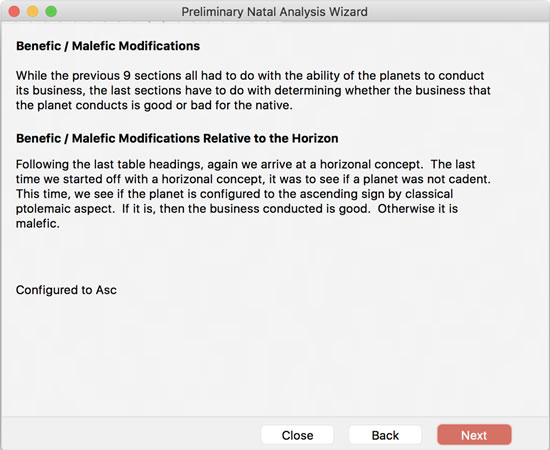
While the former sections were about the ability of the planets to conduct its business, the remaining sections have to do with whether that business is favorable or unfavorable for the native. In this case if a planet is in a place configured to the ascendant, then it promotes life for the native. If it can't see the ascendant by ptolemaic aspect, then the business of that planet goes against life. Within the context of the nautical metaphor, Schmidt says that the places configured to the ascendant are places where "ropes" are attached to the helm so that the life can be steered away from danger, while the 2nd, 6th, 8th and 12th have no ropes to pull on.
Benefic / malefic modifications relative to the lights
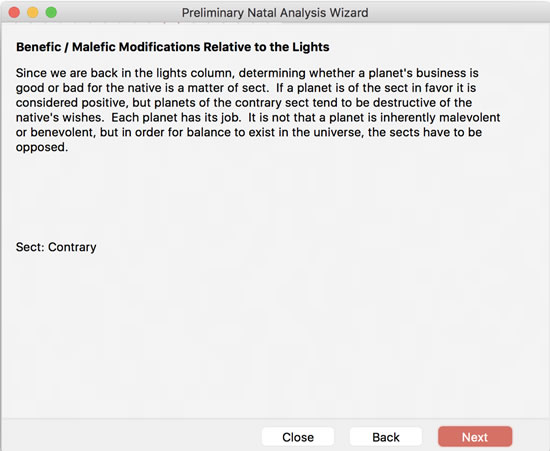
This consideration has to do with sect, especially the idea of political affiliation similar to the democratic and republican parties in the USA. One group of planets is in charge and has power whereas the remaining planets are contrary to that power. Within the context of the cosmic courtroom, this level shows whether the planet is in your defense or whether it's prosecutorial, whether that planet speaks well or ill in the cosmic courtroom.
Benefic / malefic modifications relative to the zodiac
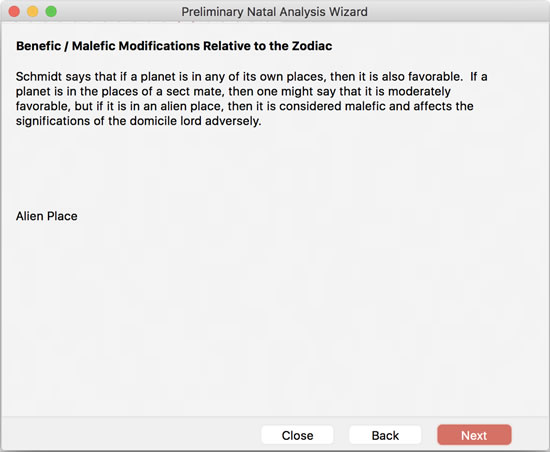
In this case we find whether the planets "political office" or situation enables it to do good or bad. These represent largely circumstantial conditions that contribute to a planets ability to effect it's own business. When it's in its own places, it can effect from its own significations and even if malefic it will do so in favorable ways for the native. These circumstantial conditions also play a strong role in elevating the eminence of an individual, so planets in their own places here tend to deflect trouble away from the native even if contrary to sect.
Rejoicing relative to the horizon
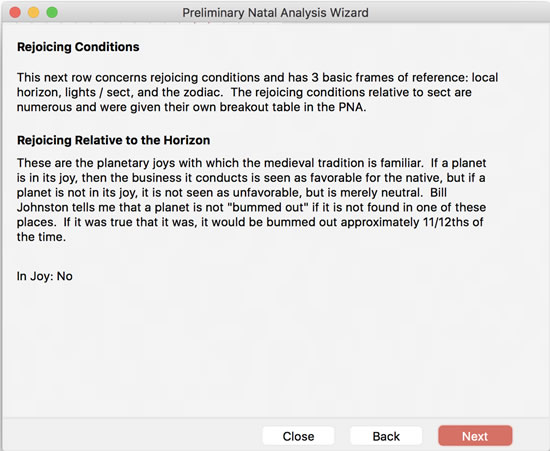
These are the classic joys of the planets according to house position (i.e. - Saturn in 12th, Mars in 6th, Sun in 9th, Moon in 3rd, Jupiter in 11th, Venus in 5th, Mercury alone rejoicing in the angle of the ascendant).
Rejoicing relative to sect on the local horizon
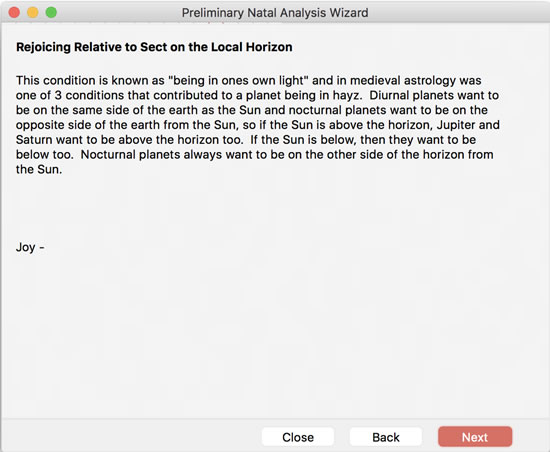
This is a more general consideration compared to the above which checks the house position. Here a planet simply wants to be in the right half of the sky (above or below the horizon) depending upon the sect of the chart. If it's a day chart, then the nocturnal planets want to be below the horizon, whereas the diurnal planets want to be above. The Sun by definition has to be above. When the Sun goes below the horizon, the nocturnal planets prefer to be above the horizon. It seems that only Jupiter and Saturn take being near the Sun well (unless it's combust).
Rejoicing relative to sect on the planetary horizon
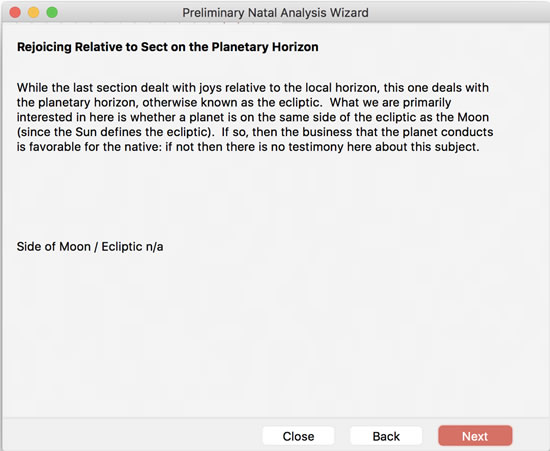
This condition is similar to the effect that the nodes of the Moon have. In this case since we are examining the Moon, it has to be on the same side of the ecliptic as itself so we have another n/a here.
Rejoicing relative to sect on the zodiacal horizon
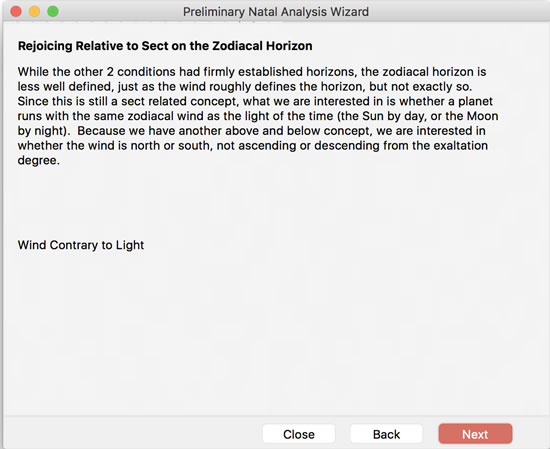
In this case we see that the Moon is in a contrary wind to the Sun. The Moon is in Gemini in this case so it's in the north wind, but the Sun in Leo is in the south wind, hence this result.
Joys relative to sect on the planetary realm
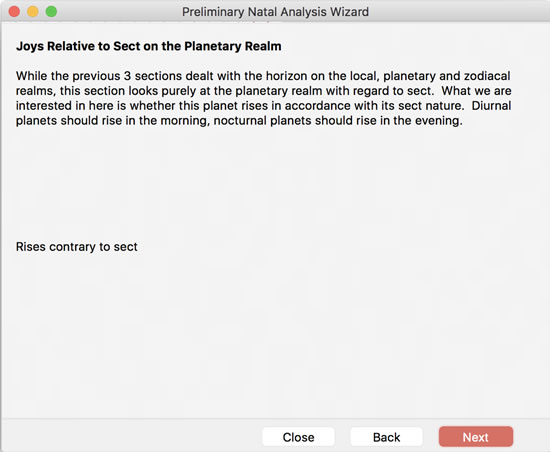
This concept is very close to doryphoros (spear bearing) where the Queen (the Moon) should be guarded with the planets in later degrees from her own position and the King (the Sun) should be guarded by planets being in preceding degrees. It too can contribute heavily to eminence of the nativity.
Joys and benefic / malefic modifications relative to the zodiac
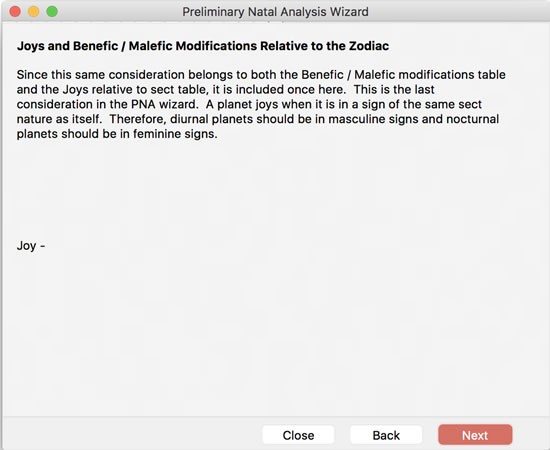
This ends the PNA wizard with the consideration of whether the planet is in a masculine or feminine sign according to its own sect status.
Universal Hermetics
While the PNA breaks down the chart and analyzes the parts, the Universal Hermetics is about looking at the life as a whole. The first two parts are about finding the chart rulers. I say rulers because the Greek source texts such as Antiochus speak of an "oikodespotes" and "kurios" and not a single planet. This rulership fits in closely with the nautical metaphor where the oikodespotes is considered to be the "political officer" and the "kurios" is considered to be the captain. There is another planet associated with the political officer that is called the "co-oikodespotes". Depending upon your predomination settings, the oikodespotes and co-oikodespotes can swap places according to Porphyry, Antiochus (domicile), Valens and Rhetorius (bound).
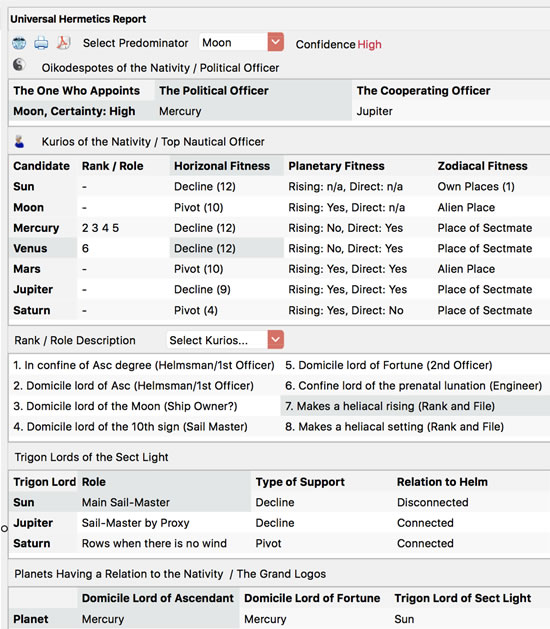
You will find buttons for the Kurios Wizard and Predomination Wizard in the Universal Hermetics window and the Nautical Wizard is found in the main menu and Group Bar. Below the Kurios consideration is a key with 8 fields, each corresponding to one of the numbers under the Rank / Role column.
The Kurios lineup of planets is shown below the consideration of the oikodespotes. Schmidt uses the nautical metaphor where officers are lined up on the ship by the admiral and asks which are not willing to take on the mission (in this case of ship's captain). Some officers won't be present or go unnoticed (under the beams), some will step back from the line (retrograde motion), and others are at varying levels of fitness, either having command experience over the helm (ascendant), or other ship operations as listed under the Rank / Role Description.
We'll deal with the trigon lords of the sect light when we get to the Nautical Metaphor Wizard below. For now, notice that at the bottom of this window is something called "Planets having a relation to the nativity". Schmidt likens this to a single sentence that describes your whole life with both a subject and direct object and a verb that describes the action between the two. If there was a single sentence that could describe your life as a whole, what would it be?
Predomination Wizard
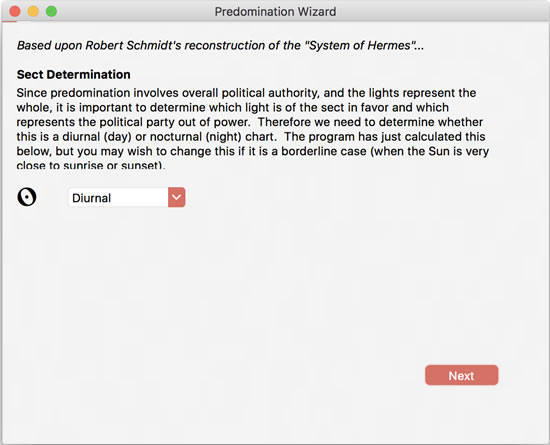
The predomination wizard allows you to change the sect of the chart for borderline conditions around sunrise and sunset to see how it affects the other data.
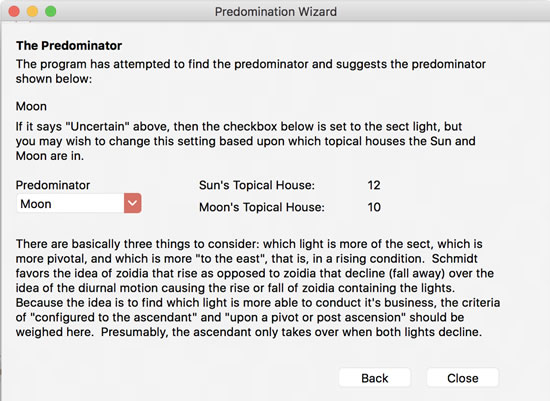
The predomination wizard then attempts to find the predominator and it will guess based upon the surviving Hellenistic texts about which of the two lights prevails under varying conditions. These are found in Valens book II and III, Antiochus, and a few other sources. It will guess with what level of certainty which will be high if there was a matching example for the chart in the original source texts. Generally when both of the lights decline, the ascendant is the predominator because the determination is still up in the air. What planet is up in the air? Mercury. The planet of suspension, which in this case joys in the ascendant because in the nautical metaphor when the ship is under power, the helm rises up toward the sky, while the stern sinks lower.
Kurios Wizard
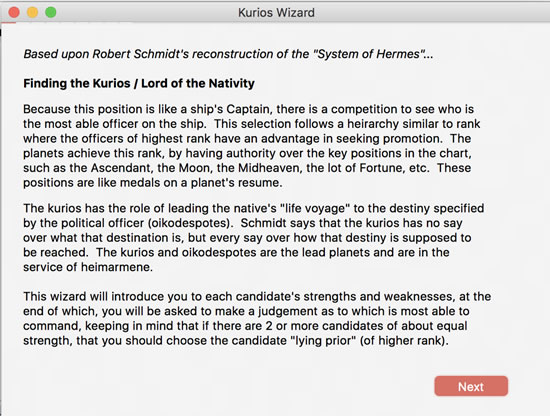
Delphic Oracle also comes with a wizard to help you select the Kurios (Captain) of the ship. It will walk you through each of the 7 visible planets to see which planets step back from the line when called (retrograde motion) and other such considerations. Another feature that isn't immediately obvious is that this wizard will point out potential "tyrannical planets". These are planets described in the texts as being powerful by being in their own places and angular, but at the same time not having any authority over "ship operations", such as being ruler of the ascendant, midheaven, the Moon or Fortune or prenatal lunation. Interestingly this typically means that a planet is in its own places in either the 7th or 4th houses, very powerful but at the same time having no authority. Who else besides spouse (7th) or parents (4th) have as much influence over ones life?
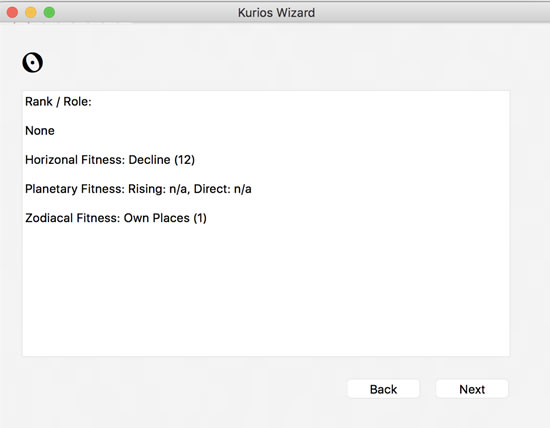
When the Rank / Role specifies none, it isn't considered as a legitimate captain in the nautical metaphor. After seeing this you can ignore the rest.
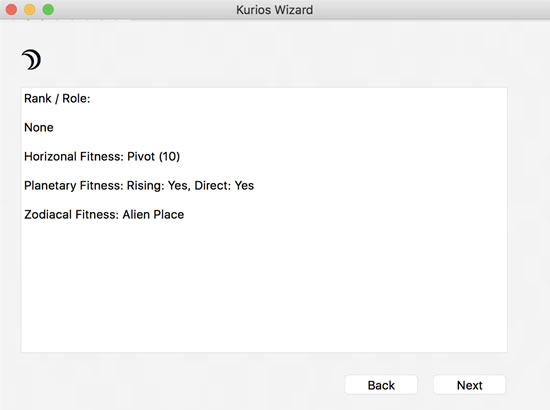
We see the case here is the same with the Moon...
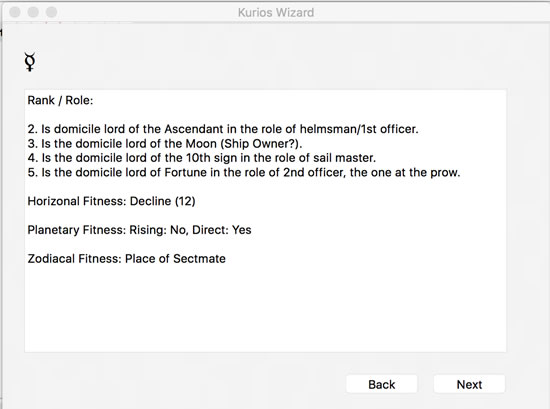
When a planet has this much experience, it's clear the admiral (or perhaps oikodespotes) is very interested in this officer, but at the same time it's clear that Mercury is a problem officer and reluctant to take on the job, but may be drafted anyway. There's a fascinating tale in Plato's Republic (the last chapter) called the "Myth of Er", which is about what a soldier saw beyond the veil after falling in battle where souls were lining up to choose a life with all sorts of ethical implications about the choice, ordering of events and the nature of balance (or balance of nature). Schmidt has said that the oikodespotes at the top of the Universal Hermetics report represents the nature of the type of life that you've chosen. Whereas the kurios (captain) is responsible for getting you there. Hermes in this case may be fullfilling a role by not being a worthy captain and indeed, if this is the captain manning the helm, Valens says that when the domicile lord (helmsman) falls amiss (12th house in this case and under the beams) then one runs the risk of "ektrope" (literally meaning to turn out or away). Within the context of the nautical metaphor, this indicates potential shipwreck. Perhapes Eddie Fisher chose the life of "drug abusing musician".
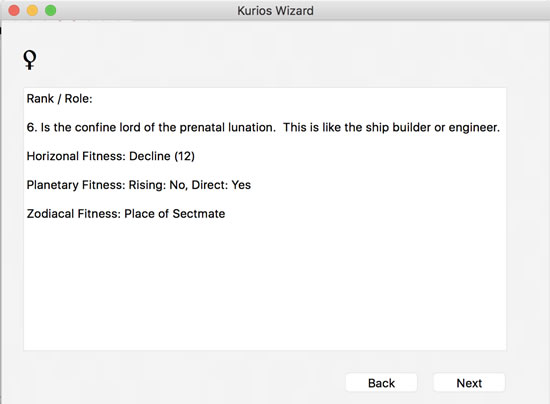
Notice that Venus has a similar situation to Mercury and the combination of Mercury and Venus are often associated with musicians in Valens texts.
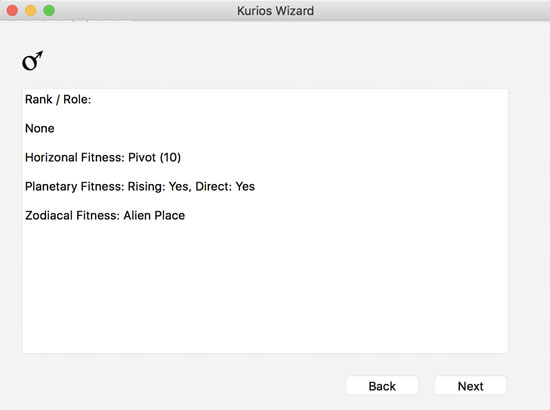
We see that Mars is pretty strong and contrary to sect causing damage to reputation, but fortunately it isn't kurios.
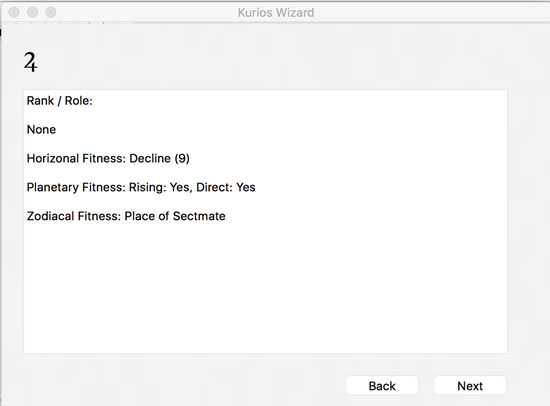
None so this officer has no experience,
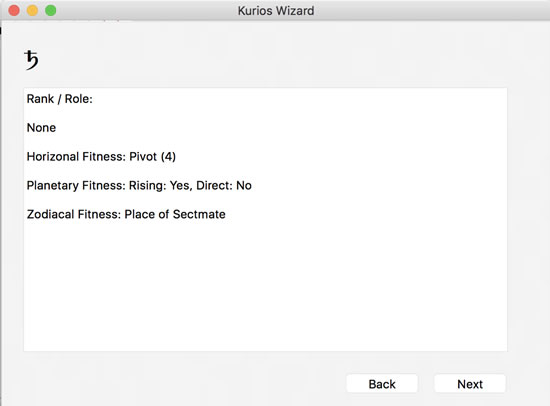
The same with Saturn which isn't considered for ships captain. Saturn is however at the position of the keel and if it had been in it's own places and direct instead, it would have been a tyrannical planet indicating that family would have a tendency to overrun this native's life.
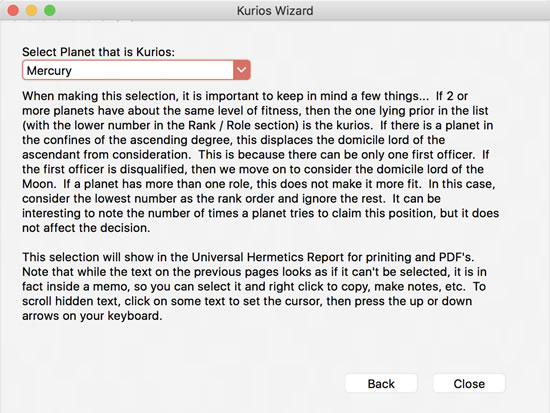
The last page asks you to decide as the astrologer what planet is kurios. This will be picked up in other areas of the program and printed out or sent to various file formats.
Nautical Metaphor Wizard
Here we come to the grand finale of the Universal Hermetics. I've already explained bits of the nautical metaphor. Now it's time to put it all together. Robert Schmidt says that the sect light (usually also the predominator) "summons the wind". The analog of this is your first breath at birth. In the context of the nautical metaphor what the sect light is doing is generating wind for the sails of your ship so that you can reach your destination / destiny. The type of ship is determined by the oikodespotes, and the kurios shows how you get to that destination (or the means by which that is accomplished). The first consideration is the helmsman (the domicile lord of the ascendant) to see if it's manning the helm and being a competent steersman of the ship. Sometimes this is the kurios and other times it might just be a lackey in place of the ships captain. If the domicile lord falls amiss as is the case here, it means that the native will have a tendency to run aground or not reach it's intended destination or runs into impediments on the way.
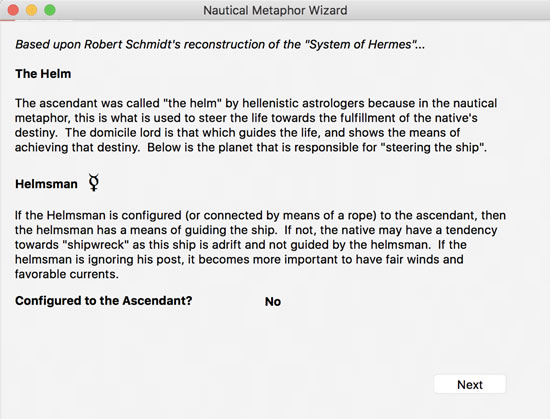
Valens says that if the domicile lord falls amiss that there is potential for ektrope (shipwreck in the context of the nautical metaphor), but just because the helm is unmanned, that's no guarantee of trouble. Valens says to look for fortune (tuche or luck) to see what befalls the native and its domicile lord. Within the context of the nautical metaphor fortune represents "accidents of wind and wave".
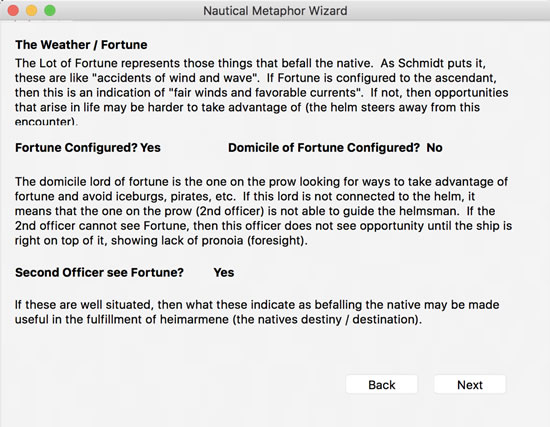
Here we get to the destination showing what kind of ship it is (oikodespotes) and what it accomplishes. This is in the nature of one of the 7 planets generally, but one can also include refinements by house position of the oikodespotes, aspects, etc... If we see that the oikodespotes (political officer) and kurios (captain) are the same planet, this increases the eminence of the native. While the native might experience difficulties, having the two chart rulers being the same planet usually makes for success even if with difficulty and lessens the chance of mutiny (in the case of tyrannical planets especially).
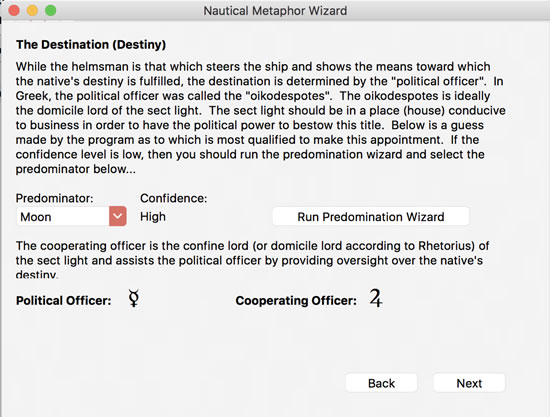
While the sect light is said to "summon the wind", the trigon lords of the sect light are said to "manage the wind". Schmidt has called these the "sail masters". Preferably the trigon lords of the sect light are upon angles (kentron or pivots) so that they have ropes to the helm (the sail masters manage the wind by setting the sails). A sail master that cannot set the wind represents the inability to respond to accidents of "wind and wave" and can cause the ship to capsize. Valens talks about the 3 trigon lords of the sect light (one by day, one by night and the one that assists both). They are set in the most general time lord system that there is "circular periods" in combination with "ascensional times of the signs". Generally the 2nd trigon lord of the sect will begin to assert it's power when the circular period of the planet completes, then gains more steam as the ascension of the zoidia that it is in completes and then finally has maximum control when the combination (the addition of the circular period to the ascension of the sign) completes. This usually marks a broad turning point when the winds change and you might be heading in a different direction in life.
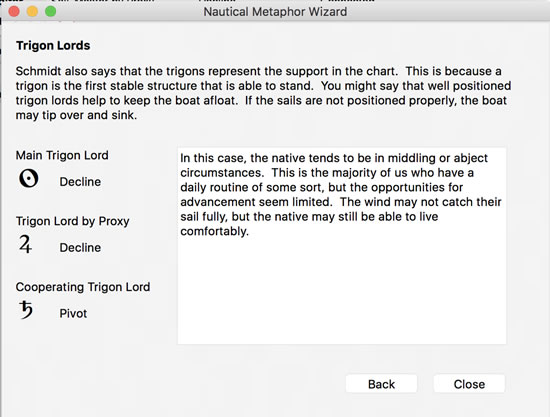
The first consideration though is whether the trigon lords are well placed or not. If they are, then it aids in the eminence of the native greatly and the native can "get far in life", but if they are in cadent places, it indicates periods when one is "becalmed in the reeds" as Schmidt puts it when one is stagnant or in trouble. From this we can see whether the native's luck is constant or there are ups and downs. Sometimes one has a great start in life and then one crashes (ektrope - shipwreck) and other times one is stagnant in the beginning coming from humble origins then rises into prominence. Then there are those who remain at their status throughout the whole life.
Topical Approach
The last subject to be dealt with here is the Topical Approach which comprises the various ways that Hellenistic era astrologers investigated areas (or topics) of life. Robert Schmidt noticed a pattern in the ancient Greek texts with the use of various words such as "epimarturia" which eventually was termed the "legal paradigm" by Robert Schmidt. He has found ranges of engagement (which later astrologers called orbs) between planets and has differentiated the various terms astrologers used for looking upon, witnessing, hurling of rays, etc that have bearing upon the Topical Approach. It's beyond the scope of this article to explain the entire range of planetary engagement. Here, I'm going to focus on how Delphic Oracle shows these planetary engagements.
When you first open Delphic Oracle and see a chart, if you have asHellenistic as your aspect style setting and you have "Show Testimony in Aspect Wheel" you can immediately tell if planets are actively engaged in an aspect relation proper or if that relationship is one of testimony.
You don't have to accept the way lines are showing though and can use different style and width / color of lines by defining colors for hard and soft aspects and testimonial relationships.
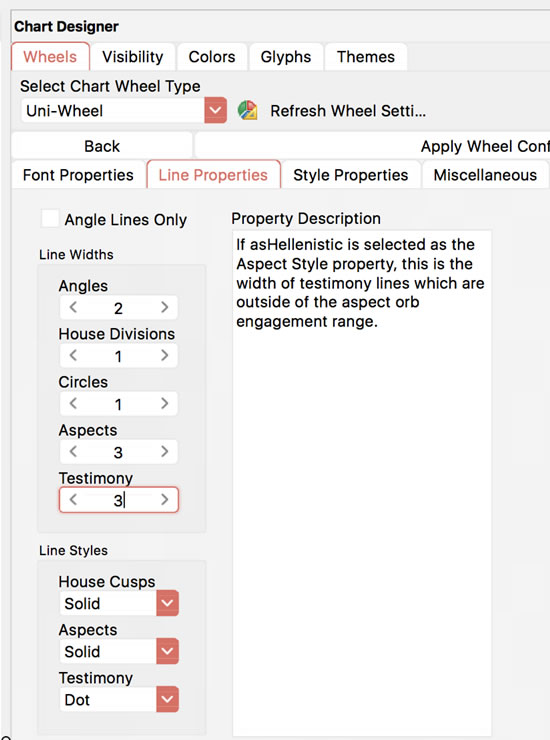
Line widths and colors can be altered as well as style of the line. In this case I've used solid lines for aspects proper (Schmidt defines this as "looking upon" and this is a 3 degree orb).
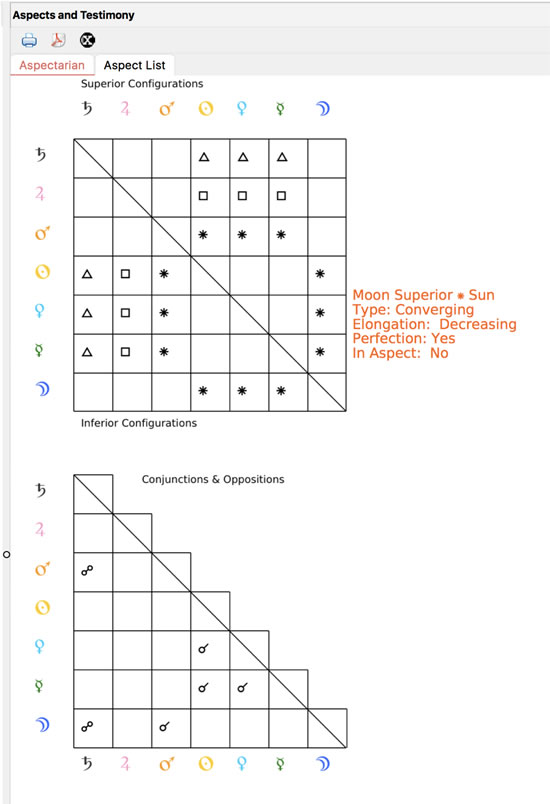
The above image shows two tables, one for conjunctions and oppositions and the other above that for superior and inferior configurations. When you hover your mouse over a cell, a hint will show (in red showing above, but in the color defined in the Chart Designer for retrograde motion). These astronomical definitions are also shown in the other tab.
Topics are also associated with houses and lots (aka Arabic Parts). The houses already have delineation text associated with the selected chart displays. Briefly, in the legal paradigm, when a planet is in the role of an "oikodektor" it is acting as an advocate for another planet or a subject matter (house) or a specific topic (lot). When planets cast rays into the various houses (or lots), they can witness what is going on, but they only provide testimony when called upon. Which planet calls upon other planets? The one playing the role of "oikodektor" which is usually the domicile lord (Antoichus explains an exception where sometimes the exaltation lord will take over or participate). So a given planet may cast a ray into the 7th house such as Venus. If the domicile lord is the Moon and the Moon casts a ray toward Venus, then Venus is called as a witness and Venus is usually going to provide some sort of testimony which depends upon her motion (whether backing away which indicates reluctant testimony or forward which is direct testimony). If Venus casts a ray into the topic, but the domicile lord doesn't call her to witness, then there is no testimony by that particular case (there are mitigation circumstances that go past this).
Schmidt has likened the Houses as "temples" where planets go to consult oracles to make decisions about various matters in a more general way. However there is still yet another way besides general signification (aspects between planets without association to houses) and here on houses, local determination. The use of lots is a way of fracturing the general significations of the planets into more specific categories. Planets naturally have a way of looking upon one another. The way Venus looks at Saturn is not the same as the way Saturn looks at Venus. Imagine an old man (Saturn) and a young woman (Venus) for instance and you will see how each glance is different. In the case of lots, because of the sect of the chart, one planet will take up the subject matter because it has greater power and the other will provide the reaction (as in the Saturn / Venus example above). These two planets also are one to define the lot of marriage. I have included Schmidt's list of the 163 lots surviving from the Paulus, Dorotheus (and others) as shown below.
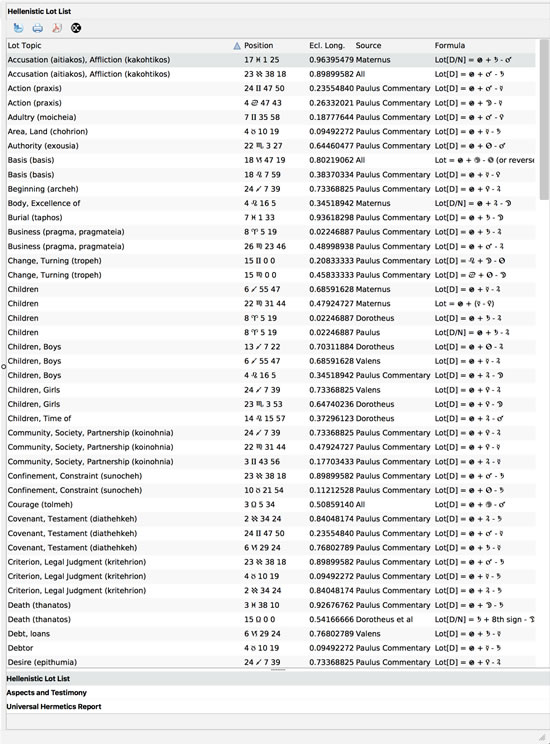
As is the case with practically every list in Delphic Oracle, the ability to sort on every column is available in both ascending and descending order by clicking on the column header. When the arrow points up, it is ascending order, and when down, descending order. (as shown below) Clicking on the Ecl Frac. column will give a sort in zodiacal order, while clicking on the lot topic will sort in alphabetic order. Click again to change ascending or descending.
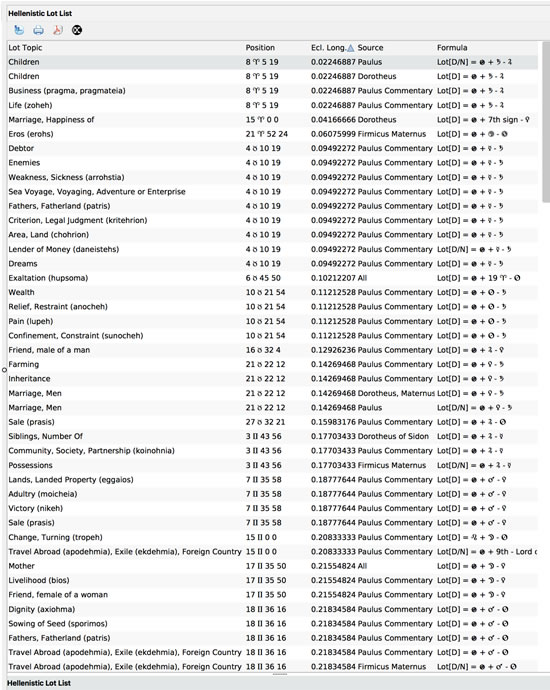
This is far from a full accounting of what's available in Delphic Oracle, more later...
